Features like these have skyrocketed the demand for Python everywhere, be it application development, Data Science, Artificial Intelligence, or any other industry. The goal behind this write-up is to round up some of the best Python books around, to help you gain the knowledge and confidence with this amazing programming language.
According to Stackoverflow, Python is the most preferred language which means that the majority of developers use python.
Python Books
Books are quite possibly one of the top sources of information about almost any topic, and in this section, we have gathered more than ten top books to help you familiarize and gain some practical knowledge with Python. Some of these books cover comprehensive knowledge about the programming language while some are excellent in giving you hands-on experience with it.
Regardless of your previous experience with Python or any programming language for that matter, we’re sure you will find some great handy tips from these books for your next project.
Disclaimer: Those affiliate links are for information purposes only.
1. Python Crash Course
Author: Eric Matthes
Publisher — No Starch Press
Difficulty Level: Beginners
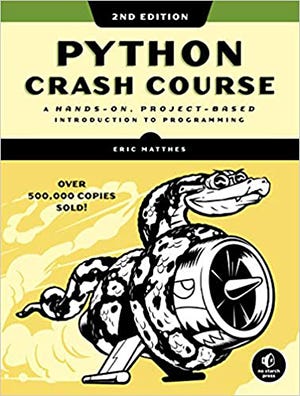
Cover of the book “Python Crash Course”
As the name suggests, the author has written this book to act as a quick crash course for readers with little to no programming exposure. The author has made all the introductory concepts as easy as ABC for beginners so that they can start implementing their knowledge on fun projects. The introductory nature of this book also makes it a fitting choice for academics.
This two-part book covers the introduction to programming in its first part, whereas in the second part, it takes on a project-driven approach where the readers are encouraged to complete any or all three programming projects. The projects include coding a 2D game, creating a data visualization program, and the last, an online Learning Log for note-taking.
2. Learning Python
Author: Mark Lutz
Publisher — O’Reilly Media
Difficulty Level: Beginners
Get Book here — Amazon
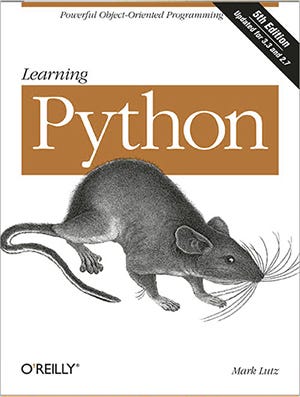
Cover of the book “Learning Python”
In the Python way of thinking, explicit is better than implicit, and simple is better than complex.
― Mark Lutz
Learning Python covers all the fundamentals of the programming language and aims to be a one-stop solution for beginners alike who are in search of an in-depth introduction to Python. Also being a two-part book like the previous one, the author Mark Lutz has tried to create a solid foundation with Python in this part, while the other part focusses more on real-life examples and situations for better practical programming exposure.
The latest edition of the book covers Python v3.3 and all its latest improvements along with the older v2.7. On a side note, if you have zero proficiency with programming, it would be a good idea to supplement this book with additional introductory references.
3. Python Tricks: A Buffet of Awesome Python Features
Author: Dan Bader
Publisher — Dan Bader (dbader.org)
Difficulty Level: Beginners
Get Book here — Amazon
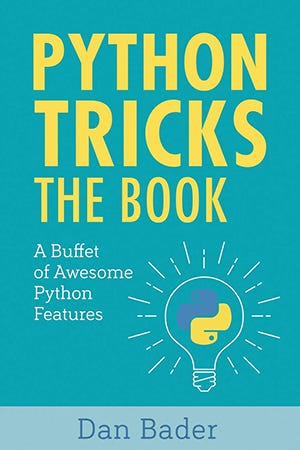
Cover of the book “Python Tricks: A Buffet of Awesome Python Features”
“There should be one — and preferably only one — obvious way to do it.”
― Dan Bader
As the title suggests, Python Tricks brings together a collection of convenient features, tips, and tricks to make you efficient with Python.
In the words of the author — “What started out as a fun twitter experiment, turned into a series of noteworthy and useful tricks accompanied by a clear code example, that helped hundreds of Python developers understand the idea behind the various aspects of Python.”
The book covers a large collection of tricks from a variety of topics in Python, and they’re presented in a well-explained style, but to make full use of this book, you’d still need a strong foundation in Python.
4. Learn Python the Hard Way
Author: Zed Shaw
Publisher — Addison-Wesley
Difficulty Level: Beginners
Get Book here — Amazon
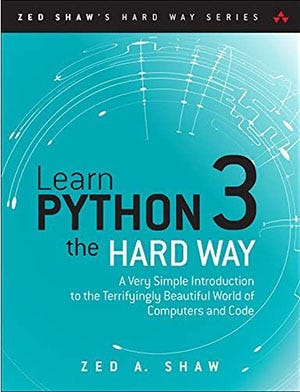
Cover of the book “Learn Python the Hard Way”
“Just take it slow and do not hurt your brain.”
If you’re intimidated by the “Hard” in the title, don’t be. That’s just the author’s way of using instructions to make you thoroughly go through the chapters and practice what you’ve learned.
Putting the title aside, the author has done an amazing job presenting the fundamental concepts of Python at a more beginner-friendly pace to prepare you for complex topics. The book also includes plenty of instructional videos and exercises to enhance your knowledge of Python. In case you’re wondering, yes, the book has been updated with a newer edition that supports Python 3.
5. Automating Boring Stuff with Python
Author: Al Sweigart
Publisher — No Starch Press
Difficulty Level: Beginners
Get Book here — Amazon
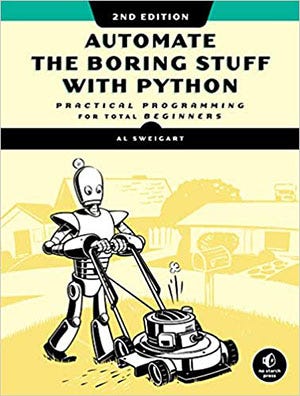
Cover of the book “Automating Boring Stuff with Python”
According to the author-
Don’t spend your time doing work a well-trained monkey could do. Even if you’ve never written a line of code, you can make your computer do the grunt work. Learn how in Automate the Boring Stuff with Python.
The title says it all. Every now and then, you must’ve come across a boring or a repetitive task that makes you say, “not this again.” It is these moments that this book intends to eliminate. The author has covered the necessary basics of the programming language in this book to help you create some nifty snippets of Python that can automate a simple but boring task to be done in seconds instead of hours.
While the book does wonders for anyone wanting to get the boring tasks out of the way quickly, sans the programming background, it does not comprehensively cover each aspect of Python’s. Good enough for creating handy throwaway code but not enough for a thorough introduction.
6. Python for Data Analysis
Author: Wes McKinney
Publisher — O′Reilly
Difficulty Level: Intermediate
Get Book here — Amazon
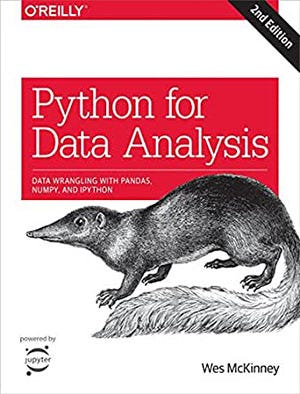
Cover of the book “Python for Data Analysis”
Python can be used for a variety of tasks, and one of them is data analysis. If you constantly find yourself occupied with analyzing and manipulating structured data or are simply keen on learning about how efficient Python can be for data analysis tasks, you might find this book useful.
The author has explained the fundamentals of working with data in a very comprehensive manner while also touching upon the topic of scientific computing. Python for Data Analysis also covers some of the most popular libraries for data analysis, such as NumPy, pandas, matplotlib, IPython, and SciPy.
“Act without doing; work without effort. Think of the small as large and the few as many. Confront the difficult while it is still easy; accomplish the great task by a series of small acts. — Laozi”
― Wes McKinney
7. Introduction to Machine Learning with Python
Author: Andreas C. Müller and Sarah Guido
Publisher — O′Reilly
Difficulty Level: Intermediate
Get Book here — Amazon

Cover of the book “Introduction to Machine Learning with Python”
The rate at which Machine Learning is advancing is fascinating. To be able to make the most out of this technology, Python is among the top choices for a glue language. Targeted towards aspiring Machine Learning professionals in search of solutions to real-world machine learning problems, this introductory book requires zero prior experience with Machine Learning.
Instead of diving into the mathematics behind the algorithms and models being used throughout, the book takes a gentler approach and explains the background and their importance. Though it does require some knowledge of using Python to implement the vast collection of algorithms and models covered by the libraries followed in the book, such asscikit-learn, NumPy, and matplotlib.
8. Python Data Science Handbook
Author: Jake VanderPlas
Publisher — O’Reilly Media
Difficulty Level: Intermediate
Get Book here — Amazon
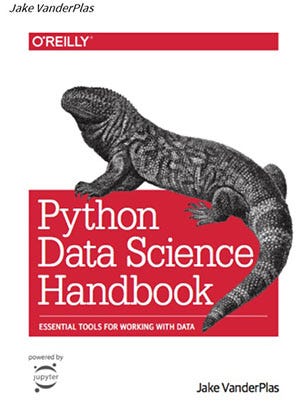
Cover of the book “Python Data Science Handbook”
Data Science is becoming more of an imperative skill in various domains lately as the benefits it offers is invaluable. The author of this handbook has put more emphasis on learning Data Science as a skill than a new domain of knowledge, as it can prove to be advantageous while applying the skill to a problem in hand.
The contents of the book have been structured into five different libraries provided by Python for extensive coverage, i.e, IPython, NumPy, Pandas, Matplotlib, Scikit-Learn. The handbook does require a certain degree of proficiency in Python to follow the book as intended by the author, and would not make for a suitable choice for beginners.
9. Head First Python: A Brain-Friendly Guide
Author: Paul Barry
Publisher — O’Reilly Media
Difficulty Level: Intermediate
Get Book here — Amazon
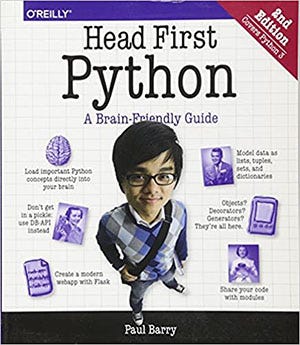
Cover of the book “Head First Python: A Brain-Friendly Guide”
“code is read more than it’s written. This”
― Paul Barry
Although this book doesn’t cover the programming language and its entirety in detail, it still manages to teach you Python in a more practical and fun way. What separates this book from others is the fun and casual style the author has used to build a connection with the readers, and more importantly, the comical use of pictures to keep the learning process intuitive.
For those of you who have just started learning Python, or any other programming language for that matter, you might have a rough time getting your head around the topics covered. If you do know the basics of programming, hop on.
10. Fluent Python
Author: Luciano Ramalho
Publisher — O’Reilly Media
Difficulty Level: Experts
Get Book here — Amazon
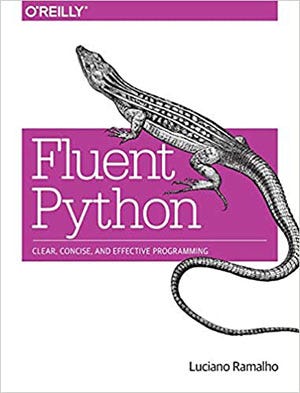
Cover of the book “Fluent Python”
Python can be a very versatile and powerful programming language when used efficiently, and this very motive is the sole driving factor for the book Fluent Python. It is clear that learning Python and achieving fluency in Python are both very different things. Most developers will often achieve what they want with Python anyways but at the cost of its full potential.
The author has emphasized on highlighting some of the less utilized features and techniques to make it possible to get the most out of Python. If you have recently started learning Python, this might not be the right book for you, as you might find it hard to follow.
11. Effective Python
Author: Brett Slatkin
Publisher — Addison-Wesley
Difficulty Level: Experts
Get Book here — Amazon
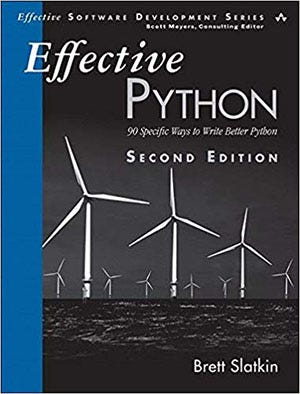
Cover of the book “ Effective Python”
Python is a programming language that puts a high emphasis on creating clear and extremely readable code, but there can still be some situations where that isn’t achieved. This is where the book Effective Python comes into the picture. The author has covered some common mistakes and provided invaluable insights and practices on how to avoid them in the first place, to write cleaner, reusable, and more effective Python code. If you’re constantly struggling to find ways to optimize your code, this could be the right book for you.
12. Python Cookbook
Author: David Beazley & Brian K. Jones
Publisher — O’Reilly Media
Difficulty Level: Experts
Get Book here — Amazon
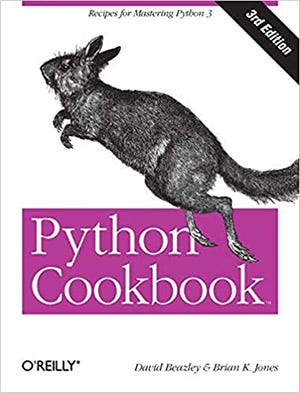
Cover of the book “Python Cookbook”
Python has an excellent community, and this book takes its inspiration from the many unique challenges faced by the community, which are referred to as recipes in the Python Cookbook. The recipes come with relevant examples and detailed background studies on the problems from some of the most insightful members of the community.
To make it absolutely clear, the author has targeted this book towards experienced Python developers looking to strengthen their understanding of the various modern techniques in Python. Beginners are suggested to pick up something that covers the introductory parts of Python before starting with the Python Cookbook.
More Python Books to Read —
- Python Pocket Reference
- Python Machine Learning
- Deep Learning with Python
- Python Programming: An Introduction to Computer Science
- Natural Language Processing with Python
- Python in a Nutshell
- Think Python: How to Think Like a Computer Scientist
- Django for Beginners: Build websites with Python and Django
Conclusion
Python is an elegant and powerful programming language that can do wonders if utilized correctly. The books covered in this write-up should provide you sufficient knowledge to get you started with Python along with some additional tips and tricks to write a clear and optimized code that works beautifully. To tie things up here, if you are keen on learning Python from scratch or would simply like a brush-up, we highly recommend you go through these books.
Note: To eliminate problems of different kinds, I want to alert you to the fact this article represent just my personal opinion I want to share, and you possess every right to disagree with it.








